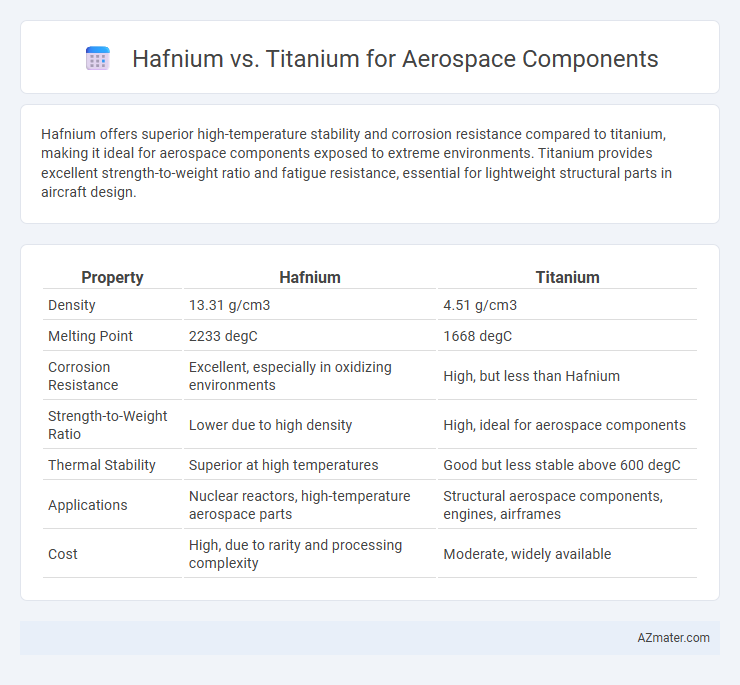Hafnium offers superior high-temperature stability and corrosion resistance compared to titanium, making it ideal for aerospace components exposed to extreme environments. Titanium provides excellent strength-to-weight ratio and fatigue resistance, essential for lightweight structural parts in aircraft design.
Table of Comparison
| Property | Hafnium | Titanium |
|---|---|---|
| Density | 13.31 g/cm3 | 4.51 g/cm3 |
| Melting Point | 2233 degC | 1668 degC |
| Corrosion Resistance | Excellent, especially in oxidizing environments | High, but less than Hafnium |
| Strength-to-Weight Ratio | Lower due to high density | High, ideal for aerospace components |
| Thermal Stability | Superior at high temperatures | Good but less stable above 600 degC |
| Applications | Nuclear reactors, high-temperature aerospace parts | Structural aerospace components, engines, airframes |
| Cost | High, due to rarity and processing complexity | Moderate, widely available |
Introduction: Importance of Material Selection in Aerospace
Material selection in aerospace is crucial for optimizing performance, safety, and durability under extreme conditions such as high temperatures and mechanical stress. Hafnium and titanium, both valuable metals, offer distinct advantages: hafnium provides superior high-temperature strength and corrosion resistance, while titanium excels in strength-to-weight ratio and fatigue resistance. Understanding these material properties enables engineers to tailor aerospace components for specific applications, enhancing overall system efficiency and reliability.
Overview of Hafnium and Titanium
Hafnium and titanium are critical metals used in aerospace components due to their unique properties. Hafnium exhibits excellent high-temperature strength, corrosion resistance, and neutron absorption, making it valuable in nuclear reactor control rods and aerospace heat shields. Titanium is renowned for its high strength-to-weight ratio, corrosion resistance, and fatigue resistance, leading to widespread use in airframes, engine parts, and structural components.
Physical Properties Comparison
Hafnium offers a higher melting point of approximately 2233degC compared to Titanium's 1668degC, providing superior heat resistance for aerospace components. Titanium exhibits a lower density of around 4.5 g/cm3 versus Hafnium's 13.31 g/cm3, making Titanium preferable for weight-sensitive applications. Both metals demonstrate excellent corrosion resistance, but Hafnium's greater thermal stability enhances its performance in extreme temperature environments.
Mechanical Strength and Durability
Hafnium exhibits superior mechanical strength and excellent resistance to high-temperature oxidation, making it a prime candidate for aerospace components exposed to extreme environments. Titanium offers an outstanding strength-to-weight ratio and remarkable corrosion resistance, which enhances durability while reducing overall aircraft weight. The combination of hafnium's exceptional heat tolerance and titanium's lightness provides aerospace engineers with material options tailored for optimal mechanical performance and long-term durability.
Corrosion and Oxidation Resistance
Hafnium exhibits superior corrosion and oxidation resistance compared to titanium, making it highly valuable for aerospace components exposed to extreme environments. Its dense oxide layer effectively protects against high-temperature oxidation, significantly outperforming titanium in oxidative stability. Titanium, while corrosion-resistant in many aerospace applications, tends to form less stable oxide films, limiting its durability under aggressive oxidative conditions.
Weight Considerations for Aerospace Applications
Hafnium's significantly higher density compared to titanium makes it less favorable for weight-sensitive aerospace components where minimizing mass is critical. Titanium alloys offer an optimal balance of high strength-to-weight ratio and corrosion resistance, making them the preferred choice for structural parts in aerospace applications. Weight considerations heavily favor titanium due to its lighter atomic weight (approximately 4.5 g/cm3) versus hafnium's much denser nature (about 13.3 g/cm3), impacting fuel efficiency and payload capacity.
Temperature and Thermal Stability
Hafnium exhibits exceptional high-temperature stability, maintaining structural integrity up to approximately 2,200degC, which surpasses titanium's operational limit of around 1,600degC. Hafnium's superior thermal stability and high melting point make it ideal for aerospace components exposed to extreme heat, such as turbine blades and rocket nozzles. Titanium, while offering excellent strength-to-weight ratio and corrosion resistance, is less effective in prolonged high-temperature environments compared to hafnium alloys.
Cost and Availability in the Aerospace Industry
Hafnium is significantly more expensive and less abundant than titanium, making titanium the preferred choice for aerospace components due to its cost-effectiveness and widespread availability. Titanium offers a high strength-to-weight ratio and excellent corrosion resistance, which meets most aerospace industry requirements without the premium price tag of hafnium. Limited global supply and higher extraction costs restrict hafnium's use to specialized aerospace applications where its superior neutron absorption or high-temperature stability is critical.
Manufacturing and Machinability Differences
Hafnium and titanium differ significantly in manufacturing and machinability for aerospace components; titanium is widely favored due to its excellent strength-to-weight ratio, corrosion resistance, and relatively easier machinability with conventional tools. Hafnium, although offering superior heat resistance and neutron absorption properties, presents challenges in machining because of its high density and reactivity, requiring specialized equipment and techniques that increase manufacturing complexity and cost. These distinctions make titanium the preferred choice for most aerospace structural parts, while hafnium is typically reserved for niche applications such as control rods and heat shields where thermal stability is critical.
Applications and Suitability: Hafnium vs Titanium in Aerospace
Hafnium is primarily used in aerospace components requiring superior neutron absorption and high-temperature corrosion resistance, making it suitable for nuclear reactor control rods and thermal shields. Titanium excels in aerospace applications due to its exceptional strength-to-weight ratio, resistance to fatigue and corrosion, and ability to maintain mechanical properties at high temperatures, ideal for airframes, engine components, and fasteners. The choice between hafnium and titanium depends on the specific functional demands, with titanium favored for structural parts and hafnium specialized for high-temperature, nuclear-related aerospace applications.

Infographic: Hafnium vs Titanium for Aerospace Component
 azmater.com
azmater.com